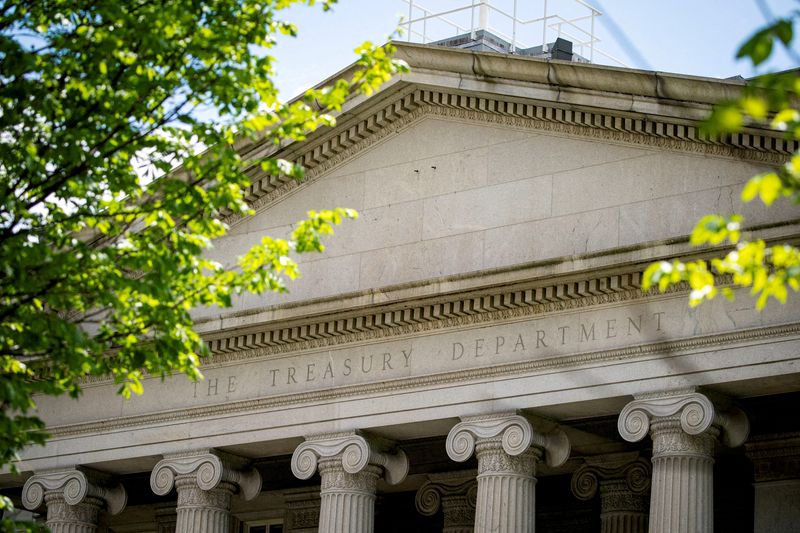By Mike Dolan
LONDON (Reuters) – The U.S. Treasury has quite a lot of debt to position within the subsequent yr, however its energetic administration of the maturity profile exhibits why the oft-heralded U.S. debt “crisis” is unlikely to happen anytime quickly.
Treasury funding math at the moment is sort of daunting, with greater than half a trillion {dollars} of payments and bonds underneath the hammer this week alone.
However virtually three-quarters of this week’s deluge is in payments, which mature in 12 months or much less, and these will roll over at progressively decrease charges if U.S. rates of interest decline as anticipated.
Whereas enormous weekly Treasury gross sales are by now acquainted, many traders proceed to flow into notes expressing concern in regards to the mounting ranges of presidency debt that want to search out prepared consumers.
Torsten Slok, the chief economist at Apollo World Administration (NYSE:), is the newest to warn of potential hazard forward along with his “Top 10” listing of Treasury factoids.
Slok notes that $9 trillion of presidency debt is maturing over the following yr, debt servicing prices have hit 12% of presidency outlays, trillion-dollar-plus deficits are projected over the following decade, and the debt/GDP ratio is predicted to double to 200% by mid-century.
His conclusion is easy: Be careful for bumpy auctions, doable credit standing downgrades, and the persistent risk that long-term bond traders will start to demand a hefty “term premium” to carry long-dated Treasuries.
However by front-loading the maturity profile of the debt, the Treasury is revealing certainly one of its most important instruments to bypass a debt crunch over the approaching yr or extra.
Despite the fact that the weighted common maturity of the whole marketable debt inventory continues to be above pre-pandemic ranges at shut to 6 years, payments maturing in a single yr or much less make up 22% of the entire – properly up from the ten%-15% seen each 18 months in the past and typical for a lot of the last decade earlier than COVID-19 hit.
With coverage charges at the moment greater than 5%, that short-term issuance might be pricey.
However the image modifications significantly if the Federal Reserve strikes into rate-cutting mode subsequent month and lops greater than 200 foundation factors off charges over the following yr, because the futures markets at the moment count on.
BUILDING BILLS
Does this imply the Treasury is intentionally distorting the U.S. authorities debt market? Analysts at CrossBorder Capital argue the Treasury is doing simply that via a coverage of “active duration management” (ADM) designed to suppress yields.
In a bit headlined “US Treasury Bribes World’s Smartest Investor,” CrossBorder fashions what that bill-heavy maturity profile may imply for debt tenors at the moment receiving much less consideration, such because the benchmark 10-year Treasury notice.
The analysts examine the yield on the latter with the much-higher yield on equal U.S. mortgage-linked bonds, adjusted for rate of interest sensitivity and the associated “convexity.”
Their mannequin exhibits a whopping 100-basis-point-plus hole between the 2, which they recommend is wholly as a consequence of this unofficial ADM coverage.
CrossBorder says a funding low cost of that dimension knocks a full 35 proportion factors off the U.S. 2050 debt/GDP ratio forecast.
So win-win? Maybe not fully.
The negatives are much less apparent, however no much less significant.
If 10-year yields are suppressed to the diploma instructed, then that is one cause why the form of the yield curve has been persistently inverted for greater than two years with out the recession many say that predicts truly unfolding.
However there are prices to shedding such a useful gizmo in forecasting the longer term course of the financial system and inflation.
Additionally, additional discount within the common maturity profile of the whole debt inventory from right here makes rollover danger a larger concern. Periodic “accidents,” similar to debt ceiling rows or momentary default threats within the invoice market, might have a disproportionate impression if publicity to payments retains rising.
And although persevering with to jam the invoice markets with new paper might cut back debt servicing prices within the close to time period, what occurs when the Fed cycle turns once more or the financial system actually is in a brand new world through which increased inflation and elevated charges persist?
That danger is particularly pertinent given present political realities. Absent a shift in fiscal coverage over the approaching years, the U.S. debt profile will ultimately require some painful changes.
And, satirically, the dearth of market ructions within the interim might truly reduce the prospect of political motion to rein within the deficits and debt, which can solely compound the issue.
However what’s additionally clear is authorities debt managers have a number of instruments and sleights of hand to assist them navigate this present interval with out producing the kind of disaster so many forecast.

Whether or not such strikes are simply momentary stopgaps is one other query. However, given latest historical past, it will appear harmful to guess that the Treasury and Fed will fail to maintain this explicit present enjoying for the foreseeable future.
The opinions expressed listed below are these of the creator, a columnist for Reuters.
(by Mike Dolan; Modifying by Paul Simao)




